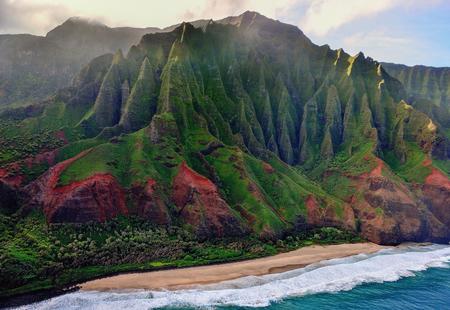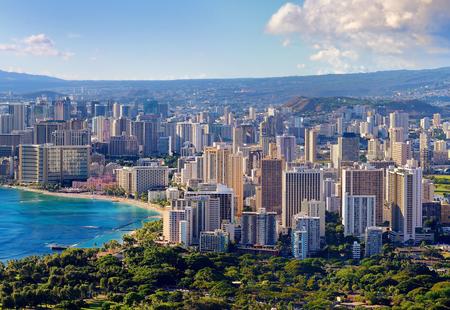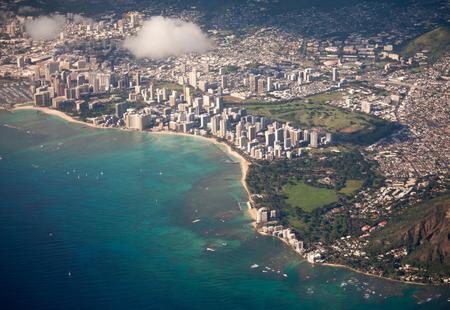Over 2,000 miles from the continental United States, and vulnerable to sea-level rise and catastrophic weather events, Hawai’i faces life threatening impacts from climate change.
It’s also long been reliant on expensive and harmful fossil fuels – spending $6.1 billion on imports in 2011 alone. Without significant changes, such heavy dependence on imported petroleum (1) would have continued to drain billions of dollars out of the state’s economy and caused price volatility for Hawaiian ratepayers.
But change was on the horizon
Thanks to an abundance of sunlight and other natural resources, coupled with progressive policymakers, in June 2015 Hawai’i became the first state in the nation to set a 100% clean energy goal in the electricity sector by 2045.
Achieving this goal calls for billions of dollars to be invested in a portfolio of renewable technologies (solar photovoltaics, wind, energy storage systems, geothermal and hydrogen to name a few). The scale of such investments means that the state needs to leverage public dollars (in the form of generous renewable energy tax credits) with private capital.

Ahead of the curve
Together with federal and state tax incentives, private capital continues to be abundant for large utility scale projects. However, way before the brought a heightened awareness of environmental justice nationwide, Hawai’i’s policymakers were already recognizing the importance of democratizing clean energy for ratepayers.
With this in mind, the Hawai’i Green Infrastructure Authority (“HGIA”), Hawai’i’s Green Bank, was constituted in November 2014 to provide non-traditional financing options for underserved ratepayers locked out of solar for financial reasons.
How the HGIA works
Included in the comprehensive plan to achieve Hawai’i’s clean energy goal is a need for 100% of all residential rooftops to make use of solar energy. This will require an additional $15.0 billion in solar and storage investments over the next 22 years.
However, there is an estimated $3.75 billion financing gap for those households unable to qualify for conventional financing at reasonable rates and terms.
HGIA is focused on expanding access and providing affordable financing for these ratepayers by leveraging innovative financing mechanisms like its Green Energy Money $aver (GEM$) On-Bill Program.
Instead of credit reports, GEM$ relies on utility bill payment history. It also steps away from debt-to-income ratios so that customers can pay for their new solar systems out of energy savings that would otherwise have been paid to the electric utility. And instead of a person, the obligation is tied to the utility meter and paid through an account holder’s electrical bill.
43% of Hawai’i’s households are rental properties as a result of high real estate costs. Ordinarily this might be expected to lock them out of green programs, but the Hawaiian Green Bank’s structure means that the obligation for solar conversion can be transferred from ratepayer to ratepayer – allowing renters to enjoy the same solar benefits as home owners.

The cost problem in Hawai’i
With its high cost of living – and the highest electricity costs in the U.S. – 44% of Hawai’i’s households are classified as asset limited, income constrained, employed (““). Of these, 15% sit below the Federal Poverty Level (FPL) and 29% sit slightly above but earn less than what it costs to make ends meet.
These families are facing disproportionate financial burdens. Rising inflation and unprecedented spikes in electricity costs (up 30% over the past year) are straining their already tight household budgets.
As an example, households earning less than 30% Area Median Income spent 11% of their income on electricity. Households below the FPL spent 15.2% of their income on electricity bills, as compared to 1.4% of total income for households in the mainland U.S.
Lowering the energy burden
HGIA’s loan fund was initially capitalised by a $150 million Green Energy Market Securitization Bond in 2014.
The bond issuance innovatively leveraged a “tried and true” rate reduction bond financing mechanism, which is typically used to rescue stranded assets. However in this instance it was rolled out to provide low-cost capital to develop clean energy infrastructure.
HGIA was the first green bank in the nation to be approved for a USDA Rural Energy Savings Program loan in May 2022 – to replenish loan capital. As a next step, we also plan to apply for funding under the Inflation Reduction Act’s Greenhouse Gas Reduction Fund.

Having impact
To date, HGIA has lowered the energy burden for over 1,800 households, nonprofits and small businesses. It’s also produced or reduced some 973,775,000 kWh, displaced 580,000 barrels of petroleum and avoided over 284,000 metric tons of greenhouse gas over the lifetime of these systems.
Vitally, HGIA has led to the creation or retention of 1,400 jobs and over $16 million has been generated in state tax revenue, with a multiplier impact of over $278 million. As we look for ways to address the climate crisis in a fair and just way, this is providing real opportunities for people across the state.
Recommendations to establish a Green Bank
I’m pleased to be able to share Hawai’i’s experiences with other states and regions in the Under2 Coalition to help realize our collective position as changemakers for our climate.
My recommendation for other states planning to establish a Green Bank are to:
- leverage aggressive clean energy and energy equity policy to establish innovative financing mechanisms (like on-bill and PACE) that allow you to expand access while mitigating risk;
- as a “start-up”, set reasonable time frames to design, implement and administer your financing program; and
- join the Coalition for Green Capital/American Green Bank Consortium for peer-to peer support and expertise.
The bottom line
Our disadvantaged households should not have to choose between paying their electric bill and putting food on the table.
With additional funding under the Greenhouse Gas Reduction Fund, I’m excited about the opportunity to help more families finance solar and storage systems to lower their energy burden while facilitating an equitable transition to renewable energy and enhancing resiliency and grid stability.
1. Hawaii imported 93% of all of its energy.






